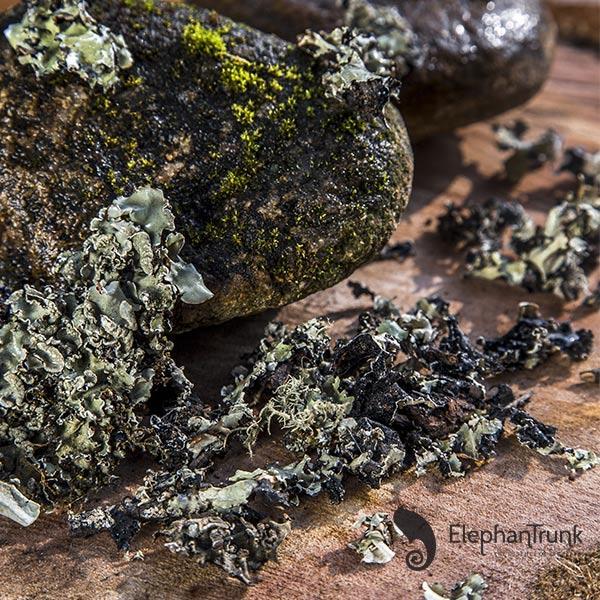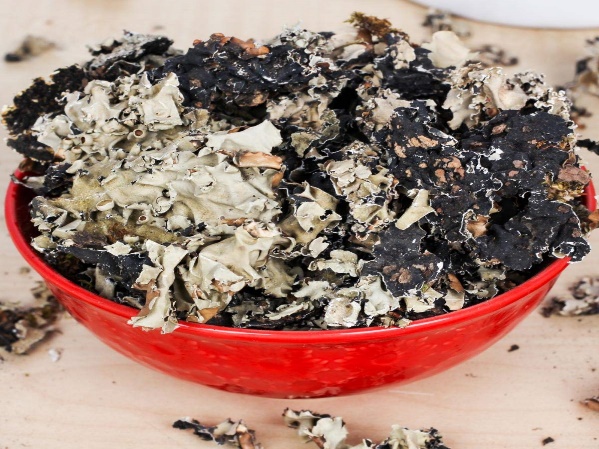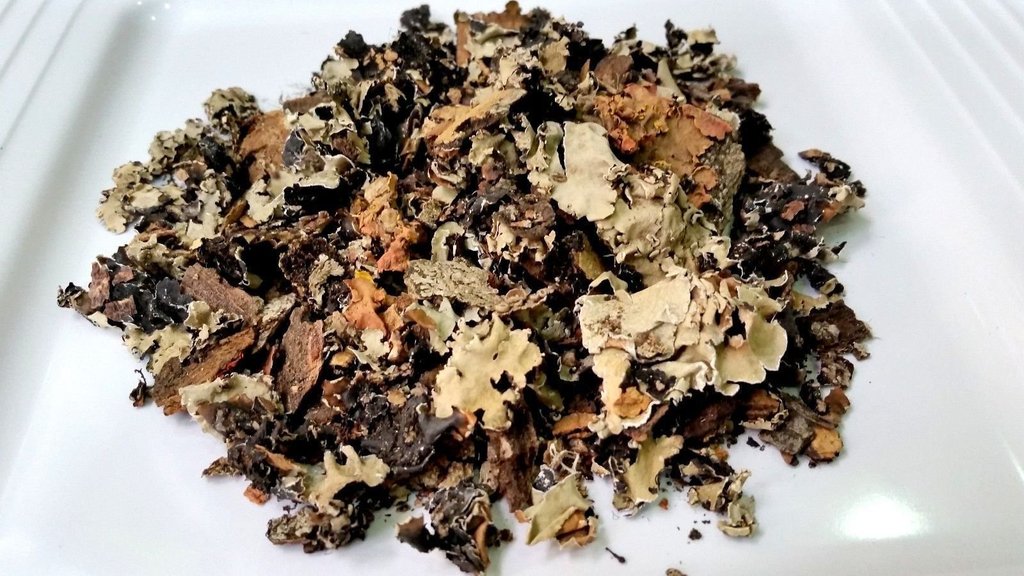Kalpasi-the mysterious stone flower
What is Kalpasi?
Kalpasi is one of the most unusual edible dried lichen flora (a type of fungus) which is very soft brown and black in color and has mild woody fragrance that usually grows on trees or rocks in running water streams or rivers in hilly station area. It is a mystery flower commonly known as different names such as Dagad phool, daagar ka phool, patthar ke phool, Black stone flower etc in india.
In Tamil, ‘Kal’ means stone and ‘paasi’ means light green moss that grows on rocks in running streams or rivers or on trees in hill stations.
There are more than 2000 variety of lichen (fungus) and every one is not edible, there are handful of few edible lichen flora which are used not poisonous and mainly used in the cooking as a spices.


Pic source-elophan trunk & Bungakalpasi/alibaba
Common Name of kalpasi:-
- Lichens species collectively called “stone flower” in English, „
- Patthar ka phool in Hindi
- Dagad phool in Marathi
- Chadilo in Gujrati
- Dagar da phool in Punjabi
- Kalachu or Kallu huvu in Karnataka
- Kalpasi in Tamil
- Rati Puvu in Telgu
- Ushn in Urdu
- Bhojhwar in assamese
- Shilapushpa in Sanskrit.
Locally in Garhwal it is known as ‘Mukku’, ‘Shewal’, ‘Jhoola’; ‘Chaarila’ in Kumaun; ‘Chaai’ and ‘Mendi’ in Himanchal. In Hindi the lichens are also known as ‘Shaik’ (meaning Shai= Shewal and K= Kawak). Commercially the lichens are sold in the name of “Charrila” or “Jhoola”.
Where does it grown in india:-
It is a small growing edible fungus that grows mainly in between the rocks, tree trunks and land throughout the hilly area, western ghat specially Tamil Nadu area, Himalaya and north east india . The species are usually found throughout the temperate Northern and Southern Hemispheres area but not much known about its typical place of production.
The black stone flowers are native to the Himalayas, from Himachal Pradesh to Arunachal Pradesh. They require a slight elevation above sea level for proper growth thus they are also found in Ooty and Kodaikanal region.


Pic source-Exporters india & Amazon
Many believe that, In south Indian state like tamil Nadu, there are few places such as Ooty and Kodaikanal etc where this rare spices are naturally harbour due to the atmospheric purity in these area. Since this spices is very peculiar in nature and it is very sensitive to the environment resulting it does not grow generally where there is any air found polluted. They require a slight elevation above sea level, which is why Ooty and Kodaikanal in Tamil Nadu are important catchment areas for the spice.
The lichens are common to abundant in temperate and alpine regions of the Himalayas and hilly regions of the peninsular India. In northern india, Garhwal Himalaya exhibits sub-mountain to alpine climate. Topography and other mountain slopes, in combination with perennial streams and dark shady localities of this area have created micro-climatic conditions to provide diverse environmental conditions suitable for the growth of lichen flora. It is typically grown on the pine tree in garhwal Himalayan region such as Kumoan
The lichens can be used as “Yardstick” and can be used to calculate the biological effect of pollutants by measuring alteration at population, community or even the species level.
How does it looks like:-
Kalpasi is a peculiar spices with a peculiar shape. The outer covering of kalpasi is greenish black with white color inside. The thallus are approx. in the size of 15cm in diameter.
They are very fragile, and quickly disintegrate, thus require really careful handling. This dried lichen flora or fungus is so light in nautre that it can easily puffed away with a blow of air from our mouth from tree or rocks where it grown.
A brief history of lichen in india:-
The word lichen is derived from a Greek word which denotes the superficial growth on the bark of olive tree. Theophrastus (370-285), the Father of Botany introduced the term lichen. Tournfort (1700 AD) proposed lichen as one of the genera of plant entities.
Lichens are generally regarded as nutritionally specialized fungi. Lichens can grow anywhere i.e. on surfaces like soil, rock or even the sides of trees. Lichens may absorb certain mineral nutrients from any of these substrates on which it grows,but is generally self-reliant in feeding itself through photosynthesis in the algal cells. Lichen can also absorb moisture from the atmosphere in the presence of high humidity and low temperature. Lichen exploration in India was initiated by European botanists, doctors and defense personals during the pre-independent period. Linnaeus (1753) was the first to record lichens from India
Culinary use of Kalpasi as a spices

Pic source-uzhavarsanthai
Since Kalpasi or patthar ke phool or Dagad ke phool is a peculiar spices with No particular shape. It is curly like some dried flower that is very light in weight. It looks curly like a cloud with a shades of black, gray, white, green and pale green in color.
Since kalpasi is peppery thin and dried out very quickly, it is usually used in spices as a dried form to extract its earth sweet flavour by tempering it at the beginning of the cooking of any dishes. It can also be grounded in the powdered form and can be sprinkled at the end of the finishing of hot dishes same as the garam masala used to sprinkle on the hot food at the last minute.
Kalpasi does not really possess any specific aroma neither in fresh or raw form nor in dried form of this spices. However, it releases a very strong earthy aroma or flavour when it is cooked or tempered in hot oil or ghee. Upon roasting this, it also releases a strong smell which is similar to the star anise smell. Kalpasi have a Sweet Aromatic flavor. Even kalpasi taste is very good in both vegetarian and non-vegetarian dishes.
kalpasi (as it is called in Tamil Nadu, where it is used in Chettinad cuisine), alternatively called dagadh ke phool (in Hyderabad) or pathar ke phool (in Uttar Pradesh, where it is used in Awadhi food), is a somewhat mysterious spice. A lichen that grows on wet stones — and mountainsides — it is elusive, rare to find.
In southern india, Kalpasi is one of the mandatory spices used in the preparation of curry powder or curry masala & Garam masala powder. It is the main matter of spices that change the taste of the same sambhar prepared in Tamil Nadu, kerala and in North India. It is all about the little nuances that go into creating a dish from ordinary to exceptional.
The spice gives the signature black color to the Maharashtrian speciality ‘goda masala’ or the Andhra vaangi baath podi. However, the blackish purple flower is often blended with other spices to make some indigenous masalas. It also used in the preparation of several meat dishes since it releases a very good aroma when tempered in hot oil during the preparation of meat items.
Kalpasi are mainly used in south and western Indian cuisine. In south Indian curry powers, kalpasi is one of the mandatory spices used in every preparation of curry powder/curry masala. it is used in traditional Chettinad food like chettinad chicken, mutton kheema kulambu, chettinad vegetable curry, mushroom curry, pakora kuzhambu etc but for most in Tamil Nadu, the spice is elusive and not regularly utilised. Chettinad fare also uses dried flower pods, and kalpasi (black stone flower) that gives their gravies a strong and distinct flavour.
In southern india, Kalpasi is the main matter of spices that change the taste of the same sambhar prepared in Tamil Nadu, kerala and in North India. It is all about the little nuances that go into creating a dish from ordinary to exceptional.
It is typically used in meat dishes like nahari (Paaya), Bombay biryani, Goat meat stews, it is also used in vegetarian dishes. It is one of the ingredients in East Indian Bottle Masala, used for cooking Meats, fish and vegetables.
it is also a vital spices in the Mughlai cuisine or Mughlai dishes such as gulawati kabab, several preparation of meat dishes, biryani etc. In Uttar Pradesh it is called patthar ka phool and is regularly used by Lucknow bawarchis in ‘potli masala, kabab masala, tandoori masala etc’. It is often used in the preparation of kabab and tradoori items.
Health Benefits of Kalpasi:
Black stone flowers or dagad phool are lichens which look like dried mushrooms or dried flowers. They are composed of fungal mycelia which form a network enclosing algal cells. They have medicinal value because of their astringent, bitter, acrid, cooling, anti-inflammatory and aphrodisiac properties.
- The black stone flower can help dissolve kidney stones.
In Ayurveda, the black stone flowers are used for the treatment of renal conditions mainly kidney stones. Its antilithiatic property help prevent urinary tract infections and the formation of renal stones. As a lithotriptic, it helps dissolve kidney stones. - Stone flowers are excellent for pain relief and skin problems.
it possess anti-inflammatory, anti-bacterial, anti-fungal, anti-viral and antimicrobial properties. It helps to reduce inflammation in the body and thus provide relief from pain. It also helps treat skin problems with its anti-fungal and antimicrobial properties. - It is a good pain reliever and it helps in healing wounds, treat skin problems and reduces inflammation.It has antibacterial properties and is very effective against protozoans and helps in respiratory disorders, tones up in urinary tract and helps in maintaining body temperature.
Popular brand name in India:-
It is easily available in Indian market from offline and online store. There are many popular brands selling kalpasi or stone flower in Indian market. The average price of kalpasi in Indian market is in the range of Rs 1500 per kg to Rs 3000/- per kg depending upon the brand and quality.
- Profchef stoneflower
- Down lee stoneflower
- Lason premium grand stone flower
- Elephan trunk kalpasi
- Tuluandu kalpasi
- Neo tea kalpasi
- Shoppee fresh
- Delicious kalpasi
- Shakti pathar phool
- Home of spices
- Nature herbs


Ref:-
- University of Karnataka research paper on Lichen
- Manglore spice.com
- The spice board of india
- The culinary cookbook
- The spice garden
- India mart & amazon
- NDTV Food
- Exports india.
- The quint.com
